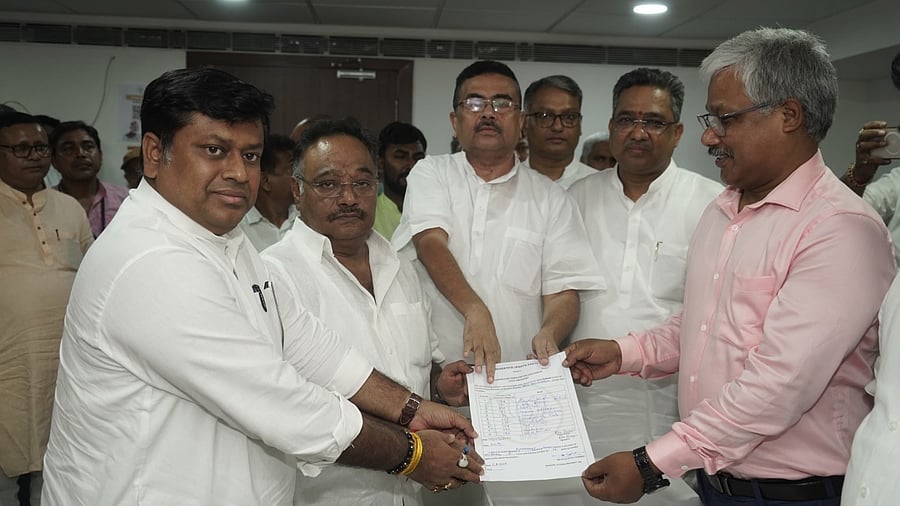
Bengal BJP chief Shamik Bhattacharya (C).
Credit: X/@paulagnimitra1
In West Bengal’s vibrant political and intellectual circles, Shamik Bhattacharya stands out as a figure who defies easy categorisation. A Rajya Sabha MP and the newly appointed West Bengal Bharatiya Janata Party (BJP) president, Bhattacharya is a study in contradictions, unified — a ‘secular BJP’ leader who pairs urban sophistication with unwavering party loyalty.
Ditching the conventional kurta-pajama for a crisp white shirt and black trousers, he projects a refined pragmatism that echoes the late Arun Jaitley. Just as Jaitley moved with ease through Delhi’s Lutyens elite, Bhattacharya, too, is deeply embedded in Kolkata’s cultural and academic circles.
Known in the city’s theatre, poetry, and art scenes, Bhattacharya maintains cross-party relationships, earning respect across ideological divides. His elevation to the helm of West Bengal’s BJP, succeeding Union minister Sukanta Majumdar, signals a strategic pivot as the party gears up for the March 2026 Assembly polls.
With Mamata Banerjee’s Trinamool Congress (TMC) dominating the state’s political landscape, Bhattacharya’s ability to bridge the BJP’s traditional base with the state’s cosmopolitan sensibilities could be the key to navigating its complex terrain.
BJP’s realisation
Assam-born Bhattacharya’s political journey began in the mid-1970s when, as a schoolboy, he attended RSS shakhas in Howrah’s Mandirtala area. He joined the BJP in the early 1980s, a time when the party had little presence in West Bengal. He rose through the ranks, starting with the Akhil Bharatiya Vidyarthi Parishad (ABVP) and later the Bharatiya Janata Yuva Morcha (BJYM), and held key roles, including state BJYM general secretary for 11 years and BJP’s chief spokesperson from 2020 to 2024.
His electoral breakthrough came in 2014, winning the Basirhat South Assembly bypoll, a rare feat for the BJP in a TMC stronghold. Despite losses in the 2016, 2019, and 2021 polls, his ideological fidelity and oratorical skills kept him central to the party. Elected to the Rajya Sabha in April 2024, Bhattacharya’s RSS roots and loyalty mark him as a trusted veteran.
His appointment reflects the BJP’s realisation that defeating Banerjee requires more than its traditional hardline Hindutva narrative, which alienates West Bengal’s significant secular and urban middle-class voters. With Muslims comprising roughly 30% of the electorate, Banerjee has capitalised on the BJP’s ‘outsider’ image to retain support, even among those disillusioned with TMC’s governance.
Bhattacharya, with his clean image and intellectual gravitas, is a departure from the polarising rhetoric of leaders like Suvendu Adhikari, who once declared the BJP didn’t need Muslim votes. In his debut speech as state president, Bhattacharya emphasised replacing “stones with books” for Muslim youth, signalling an inclusive stance to counter TMC’s narrative of the BJP as anti-minority.
By invoking West Bengal’s asmita (pride) and its historical economic contributions, he aims to craft a narrative of industrialisation, democracy, and peace against TMC’s alleged corruption and autocracy. This move harks back to the BJP’s pre-Modi era in West Bengal, when leaders like Tathagata Roy, Tapan Sikdar, and Satyabrata Mookherjee — urban, elite Bengalis — gave the party a foothold in Kolkata’s Bhadralok circles.
Sikdar’s victories in the Dum Dum Lok Sabha seat in 1998 and 1999 underscore the BJP’s past appeal among the middle class, a constituency it has since struggled to reclaim. Under Dilip Ghosh, an RSS pracharak loaned to the BJP in 2015, the party built a robust organisation, peaking with 18 Lok Sabha seats in 2019. However, Ghosh’s hardline approach and the ‘outsider’ label — amplified by Hindi-speaking central leaders — allowed Banerjee to paint the BJP as culturally alien in the 2021 polls. Majumdar’s tenure saw further setbacks, with the BJP’s Lok Sabha tally dropping to 12 in 2024, hampered by factionalism and defections.
Unifying old and new guard
Bhattacharya’s challenge is to unify a faction-ridden party. The West Bengal BJP is divided between old-guard RSS and BJP loyalists and newer members, many defectors from TMC, like Adhikari. Veterans resent these newcomers for sidelining those who toiled when the BJP was a marginal force. Bhattacharya, a 40-year party veteran, enjoys trust among grassroots workers and RSS cadre, while maintaining cordial ties with defectors and the central leadership under Narendra Modi and Amit Shah. His ability to mediate internal conflicts — evident in his good ties with Adhikari and Roy — positions him as a consensus candidate.
His strategy for 2026 focuses on rebuilding booth-level strength, countering TMC’s ‘anti-Bengali’ narrative, and appealing to the Bhadralok, whose support was pivotal for the Left in 1977 and the TMC in 2011. By emphasising West Bengal’s cultural ethos and economic revival, Bhattacharya aims to resonate with Kolkata’s middle class and urban elite, who view the BJP with scepticism. His call to opposition parties like the Left and the Congress to fight TMC independently, rather than under anti-BJP campaigns, seeks to fracture the anti-BJP vote.
Yet, challenges abound. Critics within the BJP question Bhattacharya’s organisational heft, particularly in north Bengal, a party stronghold. The TMC, despite facing corruption allegations and public anger, remains formidable under Banerjee’s leadership. Her ability to mobilise voters by framing the BJP as an external threat persists as a hurdle. Moreover, Bhattacharya must navigate the BJP’s hardline elements, balancing his moderate image with the party’s Hindutva base.
A unique figure
Bhattacharya’s ascent is a gamble on a softer, more inclusive BJP that can reclaim its 1990s-era appeal among West Bengal’s urban elite while retaining its core voters. His intellectual credibility, RSS-backed discipline, and cross-factional acceptability make him a unique figure to lead this charge. Whether he can unify the party, counter Banerjee’s narrative, and revive the BJP’s fortunes in 2026 remains uncertain.
But as West Bengal’s political cauldron simmers, Bhattacharya’s blend of sophistication and ideological fidelity offers a fresh hope for a party seeking to shed its ‘outsider’ tag and connect with the heart of West Bengal’s electorate.
(Sayantan Ghosh is a research scholar and teaches journalism at St. Xavier’s College (autonomous), Kolkata. X: @sayantan_gh)
Disclaimer: The views expressed above are the author's own. They do not necessarily reflect the views of DH.